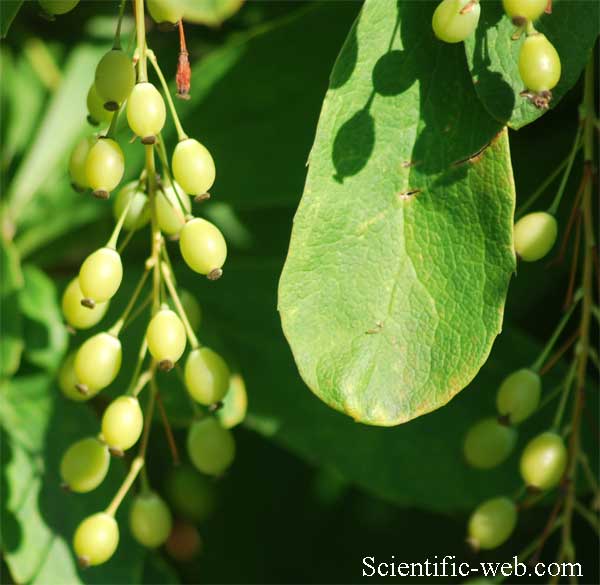
Berberis koreana, Photo: Michael Lahanas
Classification System: APG IV
Superregnum: Eukaryota
Regnum: Plantae
Cladus: Angiosperms
Cladus: Eudicots
Ordo: Ranunculales
Familia: Berberidaceae
Subfamilia: Berberidoideae
Genus: Berberis
Species: Berberis koreana
Name
Berberis koreana Palib.
Synonyms
Berberis koreana f. angustifolia (Nakai) W. T. Lee
Berberis koreana var. angustifolia Nakai
Berberis koreana f. ellipsoidea (Nakai) M. Kim
Berberis koreana var. ellipsoidea Nakai
Distribution
Native distribution areas:
Continental: Asia-Temperate
Regional: Eastern Asia
Korea (North Korea, South Korea).
References: Brummitt, R.K. 2001. TDWG – World Geographical Scheme for Recording Plant Distributions, 2nd Edition
References
Palibin, Ivan Vladimirovich (1899). Conspectus Florae Koreae. «Berberis koreana sp. n.». Trudy Imperatorskago S.-Peterburgskago Botaniceskago Sada [Acta Horti Petropolitani] (in latin) (St. Petersburg) XVII: 22. OCLC 811923835.
Links
Hassler, M. 2019. Berberis koreana. World Plants: Synonymic Checklists of the Vascular Plants of the World In: Roskovh, Y., Abucay, L., Orrell, T., Nicolson, D., Bailly, N., Kirk, P., Bourgoin, T., DeWalt, R.E., Decock, W., De Wever, A., Nieukerken, E. van, Zarucchi, J. & Penev, L., eds. 2019. Species 2000 & ITIS Catalogue of Life. Published on the internet. Accessed: 2019 Apr. 20. Reference page.
International Plant Names Index. 2019. Berberis koreana. Published online. Accessed: Apr. 20 2019.
The Plant List 2013. Berberis koreana in The Plant List Version 1.1. Published on the internet. Accessed: 2019 Apr. 20.
Tropicos.org 2019. Berberis koreana. Missouri Botanical Garden. Published on the internet. Accessed: 2019 Apr. 20.
USDA, ARS, Germplasm Resources Information Network. Berberis koreana in the Germplasm Resources Information Network (GRIN), U.S. Department of Agriculture Agricultural Research Service. Accessed: 09-Oct-10.
Vernacular names
español: Agracejo coreano
한국어: 매자나무
polski: Berberys koreański
Berberis koreana, the Korean barberry, is deciduous shrub that can grow up to 5 feet (1.5 m) in height. The species is endemic to Korea.[1] It is widely planted as an ornamental tree in North America, South America and Europe.
Distribution
Berberis koreana is endemic to Korea. It has been recently used as an ornamental tree in the United States. The genus Berberis however, ranges widely in Temperate zones of North America and Eurasia.[2] The species is reportedly naturalized in a few locations in the US State of Vermont.[3]
Habitat and ecology
Berberis koreana is a deciduous shrub that is considered hardy which means it can tolerate temperatures as low as 5 °F (−15 °C). The species can also tolerate a range of soil types; it can be in a well-drained or moist soil. B. koreana can be placed in full sun or part shade but does not prefer to be in full shade.[4]
Morphology
Berberis koreana in spring, showing flowers
Berberis koreana
Individuals of this species are deciduous shrubs with berries that are purple to red in color. The leaf margins are dentate and have inflorescences in racemes on reddish branchlets. The leaves are simple, alternating, are either elliptical or oval shape and are dark to medium-green in color. They show pinnate venation with smooth edges that are 1–3 inches (2.5–7.6 cm) in length.[2][4]
Flowers and fruit
Berberis koreana
The flowers of Berberis koreana are approximately 0.2 inches (5.1 mm) in length, appear in clusters, and are yellow in color when they bloom in the spring. B. koreana has 0.2–0.3 inches (5.1–7.6 mm) egg-shaped, red to purple berries in the fall and winter months.[4] The flower has six yellow sepals, six stamens and six petals that can be yellow to dark orange-red. B. koreana has 1-10 seeds that are tan to red-brown or black.
Uses
Food
Berberis berries are edible but sour and are used only in jams and jellies.[2][5] However eating high quantities of B. koreana berries can result in adverse side effects.[2] See Intoxication section.
Medicinal purposes
There are no established medical uses for barberry.[6] However, roots of other Berberis species were used by American Indians and settlers to help with upset stomachs, hemorrhages, tuberculosis, and eye trouble.[2] It has also been said, but not proved, that Berberis koreana can be used as an antibacterial agent.[5][6] Recent studies found that compounds synthesized from the trunk of B. koreana showed cytotoxicity against human tumor cell lines and inhibited the growth of a skin melanoma.[7][8]
Intoxication
Berberine
Several species of Berberis contain alkaloids such as berberine, canadine, columbamine, corypalmine, jatrorrhizine, and palmatine. These alkaloids are all very similar in chemical structure, but they vary in the effects they have on humans. Protoberberine relaxes smooth muscle and causes a decrease in overall blood pressure. Berberine, at high dosages, has been known to cause seizures and inhibit enzymes. Berberis can have adverse side effects such as severe digestive tract irritation that includes nausea, vomiting, and diarrhea. The side effects are not life-threatening and can be treated.[2]
References
Kim, H.; Kim, Y.-S.; Son, S.-W. (2017). "Berberis koreana". IUCN Red List of Threatened Species. 2017: e.T97529851A104406703. doi:10.2305/IUCN.UK.2017-3.RLTS.T97529851A104406703.en. Retrieved 20 November 2021.
Burrows, George Edward; Tyrl, Ronald J. (2001). Toxic Plants of North America. Iowa State University Press. pp. 255–258. ISBN 978-0813822662.
Biota of North America Program
Evans, Erv. "Shrubs: Berberis koreana". North Carolina State University College of Agriculture & Life Sciences. Archived from the original on 2009-06-30. Retrieved 2012-07-02.
"Berberis koreana - Palibin". Plants for a Future.
Bratman, Steven (2007). Collins Alternative Health Guide. Harper Collins. pp. 257–258. ISBN 9780061120183.
Kim KH, Choi SU, Lee KR (Mar 15, 2010). "Bioactivity-guided isolation of cytotoxic triterpenoids from the trunk of Berberis koreana". Bioorg Med Chem Lett. 20 (6): 1944–7. doi:10.1016/j.bmcl.2010.01.156. PMID 20176479.
Kim, Ki Hyun; Choi, Sang Un; Ha, Sang Keun; Kim, Sun Yeou; Lee, Kang Ro (30 November 2009). "Biphenyls from". Journal of Natural Products. 72 (11): 2061–2064. doi:10.1021/np900460j. PMID 19813743.
Retrieved from "http://en.wikipedia.org/"
All text is available under the terms of the GNU Free Documentation License

